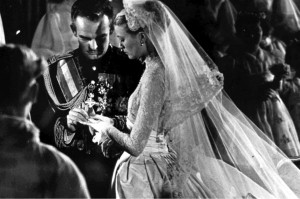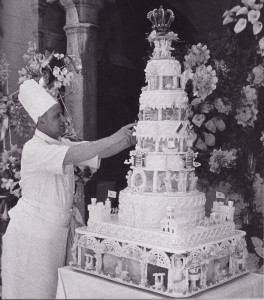As previously mentioned in Part One of My Christmas Decorations From Past Years series, I like to challenge myself every holiday season by using my Christmas decorations in different ways and sometimes in different rooms of our house every year. Shown in the photos below are a variety of decorations from several years of Christmas past.
Pine Garlands –
Some of my favorite Christmas decorations start with simple artificial pine garlands and at our home in California I frequently used them to decorate the entertainment center in the living room, the china cabinet in the dining room, the fireplace mantel in the family room and even above the bay window in the kitchen. Every year I used different Christmas items to decorate the garlands, such as a variety of glass ornaments, artificial poinsettias, holly leaves with red berries in the living room and dining room, and one year I used artificial “sugared” fruit in the dining and wonderful artificial candy decorations for the kitchen for a fun and whimsical look. (For more information about these decorated pine garlands, please click on the link to Part One of the “My Christmas Decorations From Past Years” series)
Besides using pine garlands in the interior rooms of the house, I also used them to decorate the front door of our home in California. To start the display, I hammered in several nails above the front door which I used to hang an artificial pine garland which I decorated with several artificial red poinsettias and sprays of red berries. I also hung a large artificial pine garland decorated with more red poinsettias, sprays of red berries and real pine cones.
Pine Sprays –
Artificial pine sprays are also a versatile Christmas decorating accessory that can be used to create wonderful displays in a home. During the holiday season I use several pine sprays that I place behind the picture frames of several pictures in the family room, library and dining room throughout the years in both our former California and our new home in the Midwest. Some of these pine sprays that I have used are plain and others have pine cones attached to them, I have also added red berry sprays for additional decorations.
I have also used artificial pine sprays to decorate the tops of tables, curio cabinets, fireplace mantels and even kitchen cabinets. One year I decorated the pine sprays on the top of the tall cabinet in the dining room with the artificial “sugared” fruits that matched the pine garland I used above the china cabinet, the photo above shows the display.
When we moved to the Midwest, I decided to use the gingerbread and candy decorations from the previous year’s pine garland in a different way than I had previously used above the bay window in the kitchen of our California home. In our new home there was a space above the kitchen cabinets that was the perfect spot to create a new holiday display that used several pine sprays decorated with the gingerbread and candy decorations and finished with the gingerbread train from a previous year’s display. (Please click on the link, Christmas Home Decorations, to see a photo of this display)
Also on the fireplace mantel in our Midwest family room, I decided to use several artificial pine sprays instead of a pine garland. Below are two photos that show how I decorated the pine sprays in three different years. The first year, I used two sets of pine sprays place on either side of the picture above the mantel. I decorated them with red berries, real pine cones and I also placed two sets of candles on the mantel. The next year, I placed the four pine sprays across the mantel below the picture which I decorated with red berries. I also set several family Christmas photos on either side to complete the display. (Please click on the link, Christmas Stockings/Fireplace, to see photos of these displays in another Décor post)
Finally, the following year I decided to do something a little more elaborate to include a special Christmas sign that I had recently made. In previous years I had usually displayed my Dept. 56 North Pole Village in the built-in bookshelf to the side of the fireplace but this time I set up the North Pole display on the mantel.
Tabletop Christmas Trees –
Small tabletop Christmas trees are also a very versatile accessory that I use frequently in my holiday decorating throughout our house. As previously mentioned in another Décor post entitled Christmas Trees, during the season every year I set-up several special and unique trees for family members. My husband has a Star Trek tree placed on the deck in his home office and my son has a Star Trek for his room. My daughter has another small tabletop Christmas tree for her room that I have decorated with Barbie ornaments one year, Disney princess ornaments for another year and Snowbabies miniature figurines for a different year. (For more information about decorating with Department 56 Snowbabies, please click on the link)
Even more tabletop Christmas trees have decorated the various rooms of our house throughout the years. In the entry way on a wooden bench I have displayed a Santa in a beautiful white embroidered cloak with two elves. In another room is another tree placed on the fireplace hearth with an old fashioned Santa dressed in lovely red velvet cloak with two reindeer. In the dining room on the chest of drawers is a porcelain dark-haired doll dressed in a red wool coat, hat and black fur muff and displayed with a reindeer and a wooden sled. Even in the bathroom there is woodland small Santa dressed in a green corduroy coat with a fishing creel with a small Christmas decorated with red berries and a gold star on top.
I have also repurposed my holiday decorations from other displays from previous years to use as decorations for several more tabletop trees. Above the refrigerator in our California home I decorated a small Christmas tree with chocolate candy ornaments that I had used the year before in the pine garland over the kitchen window and finished the display bay placing a gingerbread train in front of the tree.
Another tabletop Christmas tree is decorated with the Boyd’s Bears ornaments that I had previously used on the fireplace mantel in our California home. In keeping with the bear theme, the next year I decorated another Christmas tree with small stuffed teddy bears.































































